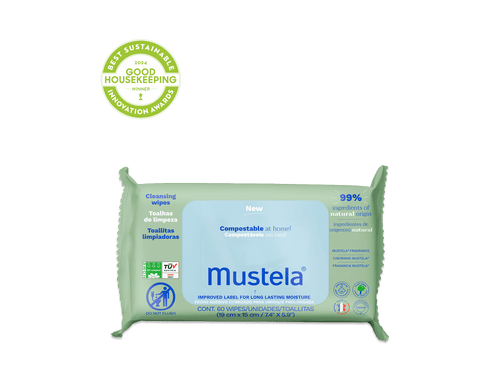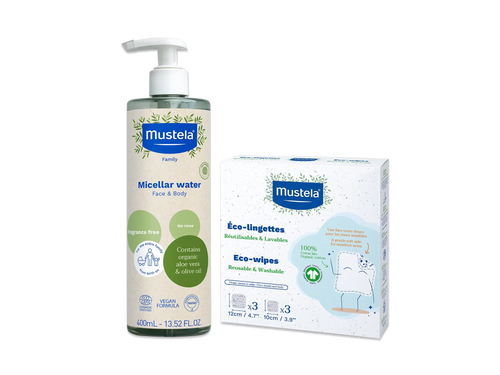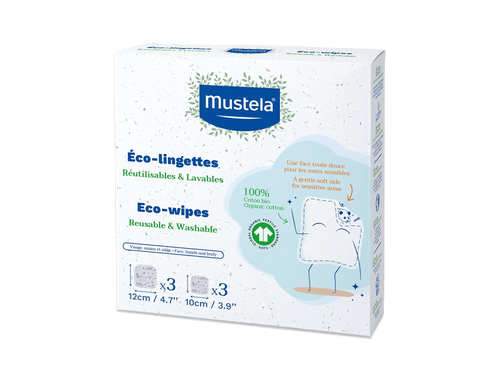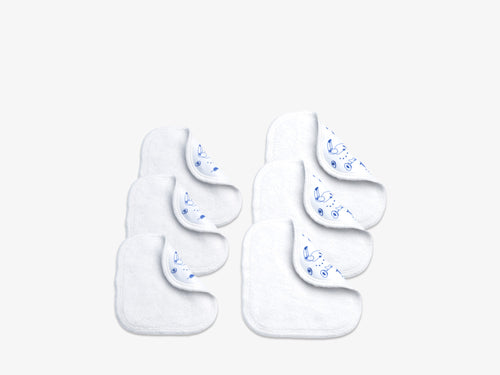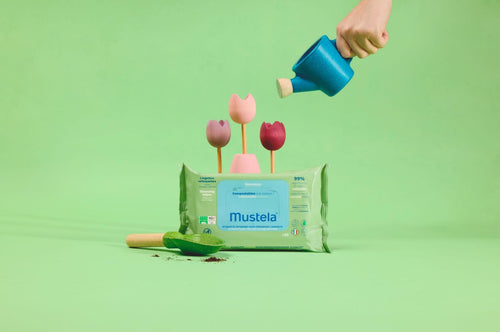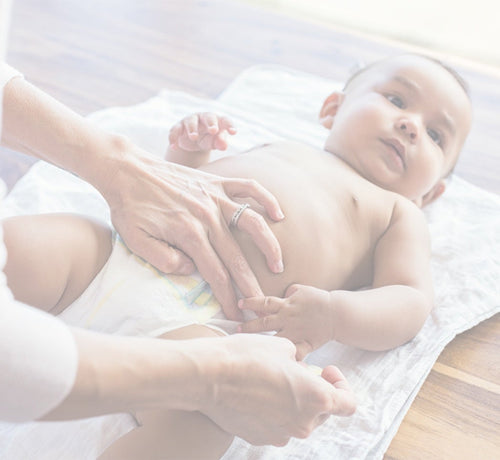There are lots of decisions to make when it comes to caring for your baby — and that includes choosing the wipes you will use to clean their bottom.
If you want to use cloth baby wipes for the sake of your baby’s skin as well as the earth, you’re in the right place! Here, we’ll discuss the benefits of using cloth baby wipes and then go over the basics of how to choose, use, and wash them.
And, if you can’t bring yourself to go the cloth wipe route or just want an option for when you’re out and about, we’ll also tell you about an organic, biodegradable baby wipe that’s a perfect alternative.
Let’s take a look.
Benefits Of Cloth Baby Wipes
Good For The Earth

One of the big advantages of using these reusable cloth wipes is that they’re earth-friendly.
Take a moment to think about how many baby wipes you go through in a day. If you use more than one at each diaper change and you change your baby’s diaper multiple times a day, you don’t even have to do the math to realize that’s a lot of baby wipes over the months and years!
But when you wash and reuse cloth baby wipes, you produce less waste and keep the landfills that much emptier.
Here at Mustela, we value efforts to care for the planet. As a B-Corp company, we are committed to doing good for the world, and we focus on creating products that leave a positive impact on society and the environment.
How do we do this?
We show respect for the environment with 100% eco-designed products and 100% responsible plant supply chains. And we guarantee the naturalness and safety of our products, which contain an average of 95% ingredients of natural origin and exclude questionable ingredients.
That brings us to our next point: Cloth baby wipes are safe for your baby’s skin.
Safe For Baby’s Skin
As long as you don’t add any questionable ingredients to cloth baby wipes when you wet them, using them allows you to steer clear of the irritating chemicals that are often found in traditional, disposable baby wipes.
That said, if your baby has very sensitive skin but you want the convenience of disposable wipes when you’re in a pinch, there are options for your little one.
Our EWG-Verified, NEA-Certified Organic Water Wipes with Cotton and Aloe are specially formulated for babies’ delicate skin. They leave your little one’s kissable skin feeling soft, soothed, and hydrated while gently cleaning it.

Cost-Effective
The last benefit we’ll mention is that using cloth baby wipes is cost-effective. That’s the good news about both cloth wipes and cloth diapers — you don’t have to keep buying them!
Simply put cloth diapers and baby wipe cloths on your baby registry, and you’ll be set.

Knowing the benefits of using cloth baby wipes, you might be hyped and ready to go! That said, if you want organic, earth-friendly, and skin-safe wipes but can’t quite bring yourself to go the reusable route, opt for our Certified Organic Water Wipes with Cotton.
These wipes are plastic-free, vegan, ultra-soft, and composed of 99.8% ingredients of natural origin, including organic cotton, organic aloe vera, and filtered, purified, and softened water.
To make our wipes as environmentally friendly and socially conscious as possible, our organic aloe vera is grown in the highlands of Mexico on farms that meet fair-trade requirements.
Meanwhile, the organic cotton we use is 100% recycled from the textile industry and part of a circular economy and anti-waste approach. The packaging contains up to 10% recycled plastic from industrial scrap and is made without a plastic lid, reducing our plastic use by 47%.
Last but not least, the wipes themselves are biodegradable and made with compostable fibers.
These earth-friendly wipes are also certified by the National Eczema Association and safe for even the most sensitive of baby skin. And they are a great option for on-the-go use since cloth wipes are a bit harder (but not impossible!) to manage when you’re out and about.
Now, let’s get back to cloth baby wipes. If you’ve decided to use them, the next section outlines just how to do so.
How To Use Cloth Baby Wipes

Choose Your Wipes
Before you start wiping your little one’s bum with cloth baby wipes, you have to choose your wipes. There are several convenient options.
You can use the soft, thin baby washcloths that you might already have in your nursery, or you can purchase specially made wipes for this purpose.
Tip: You can even make your own wipes by cutting old clothing, swaddles, and the like as long as they are made with soft, absorbent material.
Wet With Water
Once you’ve acquired wipes and it’s time to change your baby’s diaper, you’ll need to get them wet. Using plain water is one option, or you can make or purchase a special wipe solution.
If you are going to wet the wipe in the sink before the diaper change, do this before you lay your baby down to change them. This is important because you should always keep a hand on your baby once they’re on the changing table!
If you’re working with a cloth wipe solution to wet your wipes, keep it in a spray bottle near the changing table for easy use. This is also an option if you’re using plain water — it’s all up to you and what works best.
Lastly, some parents pre-wet the wipes and leave them in a wipe container. But if you go this route, you’ll need to clean the container and replace the wipes regularly to avoid bacteria growth.
Tip: If you wet the wipe in the sink right before the diaper change, use warm water for a more pleasant experience for your little one. After all, you wouldn’t want someone wiping your bottom with freezing cold water!
Ditch The Poop
If your baby is old enough to have solid poops, you’ll want to get rid of what you can before wiping their bottom.
Tip: Use the dirty diaper to remove most of the poo, then shake it into the toilet. Or use toilet paper and flush this down the toilet as well.
Wipe Your Baby’s Bottom
Now, use the damp cloth baby wipes to wipe your baby’s bottom just as you would with disposable wipes. The used wipes can go in the bin with your dirty cloth diapers.
Tip: If you’re using cloth baby wipes while you’re on the go, bring a wet bag to securely hold your dirty wipes until you arrive home. You may also want to pre-wet your wipes before leaving the house and store them in a waterproof container in your diaper bag.
Apply Diaper Cream

This part of the routine is the same as always. Apply diaper cream to your little one’s clean bum before putting on a new diaper.
Tip: If you’re using cloth diapers, use a cream that’s safe for cloth diapers, such as our EWG Verified Diaper Cream with Olive Oil and Aloe.
This talc-free formula is also dye-free and won’t stain cloth diapers or your baby’s clothing. And it’s made with 99.7% naturally derived ingredients, including aloe vera, sunflower oil, and olive oil that is sourced from family-owned groves in the South of France.
We’ve even made the packaging from sustainably sourced sugar cane and gotten rid of secondary cartons, so this product is environmentally conscious inside and out!
Wash The Cloth Baby Wipes
The last step is, of course, to wash your cloth baby wipes so you can reuse them. They can be washed along with your cloth diapers using the same routine and settings.
Tip: In addition to doing away with solid poop in the toilet, rinse or spray your dirty baby wipe after using it and before washing it. This might mean dipping the wipe in the toilet or using a diaper sprayer to spray it down.
Cloth Baby Wipes: Good For Your Baby And The Earth

You’ve read about the benefits of cloth baby wipes as well as how to use them. Now, all that’s left to do is get your own and start wiping!
If you want earth-friendly disposable wipes to use when you’re traveling or out for the day, turn to our Certified Organic Water Wipes with Cotton. Made with recycled organic cotton, these biodegradable wipes allow you to care for your baby and the earth at the same time.
Here’s to safe baby wipes and clean bottoms. Ready, set, wipe!



